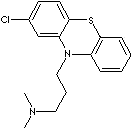PRODUCT IDENTIFICATION

H.S. CODE
TOXICITY
CLASSIFICATION
PHYSICAL AND CHEMICAL PROPERTIES
REFRACTIVE INDEX
NFPA RATINGS
AUTOIGNITION
FLASH POINT
GENERAL DESCRIPTION & APPLICATIONS
- Typical Antipsychotic
- Chlorpromazine (CAS #: 50-53-3, Phenothiazine with aliphatic side chain)
- Promazine (CAS #: 58-40-2, Phenothiazine with aliphatic side chain)
- Triflupromazine (CAS #: 146-54-3, Phenothiazine with aliphatic side chain)
- Methotrimeprazine (CAS #: 60-99-1, Phenothiazine with aliphatic side chain)
- Thioridazine (CAS #: 50-52-2, Phenothiazine with piperidine side chain)
- Mesoridazine (CAS #: 5588-33-0, Phenothiazine with piperidine side chain)
- Acetophenazine (CAS #:2751-68-0, Phenothiazine with piperazine side chain)
- Perphenazine (CAS #: 58-39-9, Phenothiazine with piperazine side chain)
- Trifluoperazine (CAS #: 117-89-5, Phenothiazine with piperazine side chain)
- Fluphenazine (CAS #: 69-23-8, Phenothiazine with piperazine side chain)
- Prochlorperazine (CAS #: 58-38-8, Phenothiazine with piperazine side chain)
- Chlorprothixene (CAS #: 113-59-7 Thioxanthene)
- Thiothixene (CAS #: 22189-31-7, Thioxanthene)
- Haloperidol (CAS #: 52-86-8, Phenylbutylpiperadine)
- Pimozide (CAS #: 2062-78-4, Phenylbutylpiperadine)
- Loxapine (CAS #: 1977-10-2, Dibenzoxazepine)
- Molindone (CAS #: 7416-34-4, Dihydroindolone)
- Atypical Antipsychotics
- Clozapine (CAS #: 5786-21-0, Dibenzoxazepine)
- Olanzapine (CAS #: 132539-06-1, Dibenzoxazepine)
- Quetiapine (CAS #: 111974-69-7, Dibenzoxazepine)
- Ziprasidone (CAS #: 138982-67-9, Benzisoxazole)
- Risperidone (CAS #: 106266-06-2, Benzisoxazole)
- Partial dopamine agonists
- Aripiprazole (CAS #: 129722-12-9, Dihydroquinolinone)
- Lithium carbonate
Chlorpromazine is the first antipsychotic agent. It is also used as an antiemetic and tranquilizer in the treatment of presurgical apprehension, manic phase of bipolar disorder, intractable hiccups, acute intermittent porphyria, and tetanus, and for the management of severe behavior disorders in children. The chemical name is 2-chloro-N,N-dimethyl-10H- Phenothiazine- 10-propanamine.
BP/USP/CP
APPEARANCE
IDENTITY
pass
ASSAY
98.0 - 102.0%
LOSS ON DRYING
1.0% max
RESIDUE ON IGNITION
0.5% max
VORATILE IMPURITY
pass
HEAVY METALS
20 ppm max